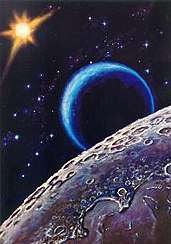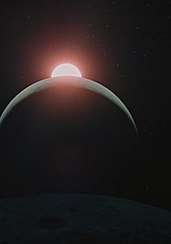Alexei Leonov
Alexei Arkhipovich Leonov[lower-alpha 1] (30 May 1934 – 11 October 2019) was a Soviet and Russian cosmonaut, Air Force major general, writer, and artist. On 18 March 1965, he became the first person to conduct a spacewalk, exiting the capsule during the Voskhod 2 mission for 12 minutes and 9 seconds.
Alexei Leonov | |
|---|---|
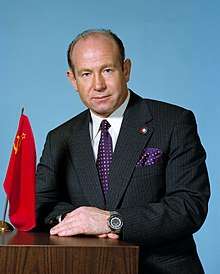 Leonov in April 1974 | |
| Born | Alexei Arkhipovich Leonov 30 May 1934 |
| Died | 11 October 2019 (aged 85) Moscow, Russia |
| Nationality | Russian |
| Occupation | Fighter pilot, cosmonaut |
| Awards | Hero of the Soviet Union (twice) |
| Space career | |
| Soviet cosmonaut | |
| Rank | Major General, Soviet Air Force[1] |
Time in space | 7d 00h 33min 03s[2] |
| Selection | Air Force Group 1 |
Total EVAs | 1 |
Total EVA time | 12 minutes, 9 seconds |
| Missions | Voskhod 2, Soyuz 19 (ASTP) |
Mission insignia |  |
| Signature | |
 | |
In July 1975, Leonov commanded the Soyuz capsule in the Soyuz–Apollo mission, which docked in space for two days with an American Apollo capsule.
Early life and military service
Leonov was born on 30 May 1934 in Listvyanka, West Siberian Krai, Russian SFSR.[3] His grandfather had been forced to relocate to Siberia for his role in the 1905 Russian Revolution. Alexei was the eighth of nine surviving children born to Yevdokia née Sotnikova and Arkhip.[lower-alpha 2][4] His father was an electrician and miner.[5]
In 1936, his father was arrested and declared an "enemy of the people". Leonov wrote in his autobiography: "He was not alone: many were being arrested. It was part of a conscientious drive by the authorities to eradicate anyone who showed too much independence or strength of character. These were the years of Stalin's purges. Many disappeared into remote gulags and were never seen again."[6] The family moved in with one of his married sisters in Kemerovo. His father rejoined the family in Kemerovo after he was released. He was compensated for his wrongful imprisonment.[4] Leonov used art as a way to provide more food for the family. He began his art career by drawing flowers on ovens and later painted landscapes on canvasses.[4]
The Soviet government encouraged its citizens to move to Soviet-occupied Prussia, so in 1948 his family relocated to Kaliningrad.[7] Leonov graduated from secondary school (No. 21) in 1953.[7] He applied to the Academy of Arts in Riga, Latvia, but decided not to attend due to the high tuition costs. Leonov decided to join a Ukrainian preparatory flying school in Kremenchug; he made his first solo flight in May 1955. While indulging in his passion for art by studying part-time in Riga, Leonov started an advanced two-year course to become a fighter pilot at the Chuguev Higher Air Force Pilots School in the Ukrainian SSR.[7]
On 30 October 1957, Leonov graduated with an honours degree and was commissioned a lieutenant in the 113th Parachute Aviation Regiment, part of the 10th Engineering Aviation Division of the 69th Air Army in Kiev.[7] On 13 December 1959, he married Svetlana Pavlovna Dozenko[8] a day before he moved to East Germany to his new assignment with the 294th Reconnaissance Regiment of the 24th Air Army.[7]
Soviet space programme

He was one of the 20 Soviet Air Forces pilots selected to be part of the first cosmonaut training group in 1960.[9] As most cosmonauts, Leonov was a member of the Communist Party of the Soviet Union. His walk in space was originally to have taken place on the Voskhod 1 mission, but this was cancelled, and the historic event happened on the Voskhod 2 flight instead.[10] He was outside the spacecraft for 12 minutes and nine seconds on 18 March 1965, connected to the craft by a 4.8-metre (16 ft) tether.[9] At the end of the spacewalk, Leonov's spacesuit had inflated in the vacuum of space to the point where he could not re-enter the airlock.[9] He opened a valve to allow some of the suit's pressure to bleed off and was barely able to get back inside the capsule.[9][11] Leonov had spent eighteen months undergoing weightlessness training for the mission.[12]
In 1968, Leonov was selected to be commander of a circumlunar Soyuz 7K-L1 flight. This was cancelled because of delays in achieving a reliable circumlunar flight (only the later Zond 7 and Zond 8 members of the programme were successful) and the Apollo 8 mission had already achieved that step in the Space Race. He was also selected to be the first Soviet person to land on the Moon, aboard the LOK/N1 spacecraft.[10] This project was also cancelled. (The design required a spacewalk between lunar vehicles, something that contributed to his selection.) Leonov was to have been commander of the 1971 Soyuz 11 mission to Salyut 1, the first crewed space station, but his crew was replaced with the backup after one of the members, cosmonaut Valery Kubasov, was suspected to have contracted tuberculosis (the other member was Pyotr Kolodin).[13]
Leonov was to have commanded the next mission to Salyut 1, but this was scrapped after the deaths of the Soyuz 11 crew members, and the space station was lost.[14] The next two Salyuts (actually the military Almaz station) were lost at launch or failed soon after, and Leonov's crew stood by. By the time Salyut 4 reached orbit, Leonov had been switched to a more prestigious project.[15][16]
Leonov's second trip into space was as commander of Soyuz 19, the Soviet half of the 1975 Apollo-Soyuz mission—the first joint space mission between the Soviet Union and the United States.[15][17]
From 1976 to 1982, Leonov was the commander of the cosmonaut team ("Chief Cosmonaut") and deputy director of the Yuri Gagarin Cosmonaut Training Center, where he oversaw crew training. He also edited the cosmonaut newsletter Neptune. He retired in 1992.[10]
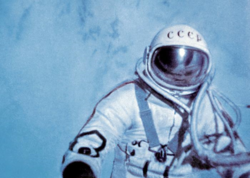 March 1965, the first space walk
March 1965, the first space walk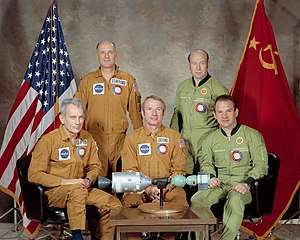 Apollo-Soyuz crew in 1975
Apollo-Soyuz crew in 1975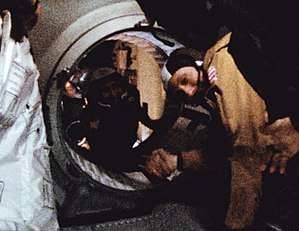 The historic handshake between Leonov and Tom Stafford
The historic handshake between Leonov and Tom Stafford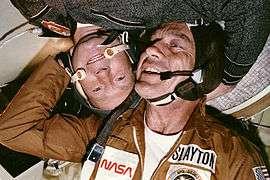 Leonov (left) with Deke Slayton in the Soyuz spacecraft
Leonov (left) with Deke Slayton in the Soyuz spacecraft
Later life and death
Leonov was an accomplished artist whose published books include albums of his artistic works and works he did in collaboration with his friend Andrei Sokolov. Leonov took coloured pencils and paper into space, where he sketched the Earth and drew portraits of the Apollo astronauts who flew with him during the 1975 Apollo–Soyuz Test Project.[18][19] Arthur C. Clarke wrote in his notes to 2010: Odyssey Two that, after a 1968 screening of 2001: A Space Odyssey, Leonov pointed out to him that the alignment of the Moon, Earth, and Sun shown in the opening is essentially the same as that in Leonov's 1967 painting Near the Moon, although the painting's diagonal framing of the scene was not replicated in the film. Clarke kept an autographed sketch of this painting—which Leonov made after the screening—hanging on his office wall.[20] Clarke dedicated 2010: Odyssey Two to Leonov and Soviet physicist Andrei Sakharov;[21] and the fictional spaceship in the book is named Cosmonaut Alexei Leonov.[22]
Together with Valentin Selivanov, Leonov wrote the script for the 1980 science fiction film The Orion Loop.[23]
In 2001, he was a vice president of Moscow-based Alfa-Bank and an adviser to the first deputy of the Board.[24]
In 2004, Leonov and former American astronaut David Scott began work on a dual memoir covering the history of the Space Race between the United States and the Soviet Union. Titled Two Sides of the Moon: Our Story of the Cold War Space Race, it was published in 2006. Neil Armstrong and Tom Hanks both wrote introductions to the book.[25]
Leonov was interviewed by Francis French for the book Into That Silent Sea by Colin Burgess and French.[26]
Leonov died on 11 October 2019 after a long illness in Moscow. His funeral took place on 15 October.[27] He was 85[28] and the last living member of the five cosmonauts in the Voskhod programme.[29] He was survived by his wife Svetlana Dozenko, daughter Oksana, and two grandchildren; his other daughter, Viktoria, died in 1996.[30]
Legacy

- The Leonov crater, near Mare Moscoviense (Sea of Moscow) on the far side of the Moon, was named after Leonov in 1970.[31][32]
- 9533 Aleksejleonov, an asteroid first observed in 1981, was named for him.[33]
- Leonov, along with Rusty Schweickart, established the Association of Space Explorers in 1985. Membership is open to all people who have orbited the Earth.[34]
- The 2017 film The Age of Pioneers (Russian: Vremya Pervykh) is based on Leonov's account of the Voskhod 2 mission. Leonov was portrayed by Yevgeny Mironov.[35][36] He was a technical adviser for the movie; the director cut all scenes featuring Gagarin–about 40 minutes of film–so Leonov could be the focus.[37]
- The song "E.V.A." by Public Service Broadcasting on their 2015 album, The Race for Space, references Leonov becoming the first man to undertake extravehicular activity in space.[38]
- In the 2019 alternate history television series, For All Mankind, Leonov is portrayed as the first person to walk on the Moon.
- Dark Ambient artist BlackWeald dedicated his 2020 album to Leonov, setting the journey of Voskhod 2 into space-themed ambient music.
Soviet/Russian awards and honours
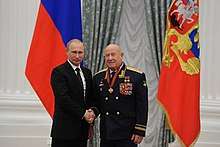
.jpg)
- Twice Hero of the Soviet Union (23 March 1965[39] and 22 July 1975[40])
- Two Orders of Lenin (23 March 1965[41] and 22 July 1975[40])
- Pilot-Cosmonaut of the USSR (1965)[41]
- Merited Master of Sport of the USSR (1965)[8]
- Order of the Red Star (1961)[8]
- Order for Service to the Homeland in the Armed Forces of the USSR, 3rd class (1975)[8]
- Jubilee Medal "Twenty Years of Victory in the Great Patriotic War 1941–1945"
- Jubilee Medal "40 Years of the Armed Forces of the USSR"
- Jubilee Medal "50 Years of the Armed Forces of the USSR"
- Jubilee Medal "60 Years of the Armed Forces of the USSR"
- Jubilee Medal "70 Years of the Armed Forces of the USSR"
- Medal "Veteran of the Armed Forces of the USSR"
- Medals "For Impeccable Service", 1st, 2nd and 3rd classes
- Lenin Komsomol Prize (1980)[42]
- USSR State Prize (1981)[42]
- Order for Merit to the Fatherland, 4th class (2 March 2000)[43]
- Order of Friendship (12 April 2011)[44]
- Order "For Merit to the Fatherland", 3rd class (22 May 2014)[45]
- Order "For Merit to the Fatherland", 1st class (29 May 2019)[46]
Foreign awards
- Hero of Socialist Labour (People's Republic of Bulgaria, 1965)[8]
- Order of Georgi Dimitrov (People's Republic of Bulgaria, 1965)[8]
- Artur Becker Medal (German Democratic Republic, 1965)[8]
- Order of Karl Marx (German Democratic Republic, 1965)[8]
- Order of the Flag of the Republic of Hungary (1965)[8]
- Hero of Labor (Democratic Republic of Vietnam, 1966)[8]
- Order of Civil Merit, 1st class (Syria, 1966)[8]
- Order of Merit, 3rd class (Ukraine, 2011)[47]
Public organisations
.jpg)

- 1975 Gold Space Medal from the Fédération Aéronautique Internationale (FAI) in 1976. FAI created an exception which allowed Thomas P. Stafford to be awarded it alongside him; typically the award is restricted to one person per year.[48][49]
- International Space Hall of Fame (1976)[50]
- International Air & Space Hall of Fame, inducted in 2001, along with Valeri Kubasov, Vance D. Brand, Deke Slayton, and Thomas P. Stafford[51]
- Ludwig Nobel Prize (2007)[52][53]
- Elmer A. Sperry Award (US, 2008), with Konstantin Bushuyev, Thomas P. Stafford, and Glynn Lunney[54]
- Order of Saint Constantine the Great (Union of the Golden Knights of the Order of St. Constantine the Great)[8]
- Order "Golden Star" (Foundation Heroes of the Soviet Union and Heroes of the Russian Federation)[8]
- Order the "Pride of Russia" (Foundation for the "Pride of the Fatherland", 2007)[8]
- National Award "To the Glory of the Fatherland" in the "Glory to Russia" class (International Academy of Social Sciences and International Academy of patronage, 2008)[8]
- Order of "the Glory of the Fatherland", 2nd class (2008)[8]
Other awards and titles
- Commander of the Order of Saint Anna III degree (2008), by Grand Duchess Maria Vladimirovna of Russia[55]
- Commander of the Order of Saint Anna II degree (2011), by Grand Duchess Maria Vladimirovna of Russia[55]
- Honorary member of the Russian Academy of Arts[56]
See also
- Attempted assassination of Leonid Brezhnev (Moscow, 1969), in which a gunman fired 14 shots at a limousine carrying Leonov and other cosmonauts.
Notes
References
- "Soyuz Crew Eager for Another Flight". The New York Times. UPI. 23 July 1975. p. 55.
- Burgess & Hall 2009, p. 383.
- Burgess & Hall 2009, p. 54.
- Burgess & Hall 2009, p. 55.
- French & Burgess 2007, p. 353.
- Scott & Leonov 2004, p. 8.
- Burgess & Hall 2009, p. 56.
- "Алексей Архипович Леонов" [Alexei Arkhipovich Leonov]. Космическая энциклопедия ASTROnote [Space Encyclopedia ASTROnote]. Archived from the original on 11 October 2019. Retrieved 11 October 2019.
- "Alexei Leonov: First person to walk in space dies aged 85". BBC News. 11 October 2019. Retrieved 11 October 2019.
- Hall & Shayler 2003, pp. 332–333.
- McKinnon, Mika (18 March 2015). "50 Years Ago, The First Spacewalk Nearly Ended in Tragedy". Gizmodo. Retrieved 28 January 2018.
- "Cosmonaut Leonov recalls life-threatening challenges during historical space walk". UNIS Vienna. 2015. Retrieved 12 October 2019.
- Evans, Ben (20 February 2014). "Valeri Kubasov, Veteran ASTP Cosmonaut, Dies Aged 79". America Space. Retrieved 11 October 2019.
- Hall & Shayler 2003, p. 173.
- Hall & Shayler 2003, p. 210.
- Harland & Catchpole 2002, p. 77.
- Dicati 2017, p. 61.
- "Alexei Leonov, the Artistic Spaceman". ESA. 4 October 2007. Retrieved 17 October 2018.
- "Alexei Leonov: winner of the 2005 IAAA Lucien Rudaux Memorial Award". Archived from the original on 1 July 2007. Retrieved 2 July 2007.
- Clarke, Arthur C. (1982). "Author's Note". 2010: Odyssey Two. New York: RosettaBooks. pp. xvii–xviii. ISBN 9780795324826. OCLC 846909138. Clarke describes the painting itself in Chapter 12 of the book.
- Suplee, Curt (16 November 1982). "The Galactic Dreamer Returns". The Washington Post. Retrieved 11 October 2019.
- Broad, William J. (2 December 1984). "Science Facts Help Propel Science Fiction in the Film 2010". The New York Times. Retrieved 11 October 2019.
- Abibulaev, Valery (2 April 2009). "Алексей Леонов: 'Выбирать актеров меня просил Михалков'" [Alexei Leonov: 'Mikhalkov asked me to choose actors']. Komsomolskaya Pravda (in Russian). Retrieved 11 October 2019.
- "Aleksei Leonov and Alexander Gafin become members of the American Pushkin Academy of Art". Alfa-Bank. 23 February 2001. Retrieved 8 July 2007.
- "Two Sides of the Moon | Alexei Leonov | Macmillan". US Macmillan. Retrieved 11 October 2019.
- French & Burgess 2007, p. 396.
- "Soviet Cosmonaut Alexei Leonov Dies at 85". Sputnik News. 11 October 2019. Retrieved 11 October 2019.
- Leman, Jennifer (11 October 2019). "Alexei Leonov, the First Man to Walk In Space, Has Died". Popular Mechanics. Retrieved 11 October 2019.
- Brown, Mark (31 August 2015). "First picture drawn in space to appear in cosmonauts show in London". The Guardian. ISSN 0261-3077. Retrieved 11 October 2019.
- Alexei Leonov obituary The Guardian, 22 October 2019.
- Leonov, Gazetteer of Planetary Nomenclature, International Astronomical Union (IAU) Working Group for Planetary System Nomenclature (WGPSN)
- McElheny, Victor K. (15 August 1970). "Armstrong, Aldrin, Collins on Moon again–as Names". The Boston Globe. Boston, Massachusetts. p. 16 – via Newspapers.com.
- "9533 Aleksejleonov (1981 SA7)". JPL Small-Body Database. Retrieved 12 October 2019.
- Arthur, Allison (23 November 2010). "Fabian named distinguished member of Association of Space Explorers". Port Townsend Leader. Retrieved 11 October 2019.
- "First man to conduct spacewalk, Alexei Leonov, dies". AFP.com. Retrieved 11 October 2019.
- "Alexei Leonov, the first human to walk in space, has died. Relive his historic spacewalk through archival footage". Meduza. 11 October 2019. Retrieved 22 February 2020.
- Egorov, Boris (12 April 2019). "3 biopic space films about the USSR's journey into the unknown". Russia Beyond. Retrieved 12 October 2019.
- Porzucki, Nina (10 April 2015). "British musical duo Public Service Broadcasting takes us on the race for space". PRI. Retrieved 12 October 2019.
- Bradsher, Henry S. (23 March 1965). "Moscow Gives Greatest Gala Welcome to Russia's Newest Cosmonauts". The Fresno Bee. Fresno, California. Associated Press. p. 5 – via Newspapers.com.
- "Astronaut Foresees Space Shuttle Age". Standard-Speaker. Hazleton, Pennsylvania. Associated Press. 22 July 1975. p. 2 – via Newspapers.com.
- Shabad, Theodore (24 March 1965). "Soviet Spacemen Get Big Welcome". The Tennessean. Nashville, Tennessee. The New York Times News Service. p. 3 – via Newspapers.com.
- "Биография космонавта Алексея Леонова" [Biography of cosmonaut Alexei Leonov]. ТАСС (in Russian). 11 October 2019. Retrieved 11 October 2019.
- "Указ Президента Российской Федерации от 02.03.2000 г. № 457" [Decree of the President of the Russian Federation of 2 March 2000, No. 457]. Kremlin (in Russian).
- "Указ Президента Российской Федерации от 12 апреля 2011 года № 434 "О награждении орденом Дружбы"" [Decree of the President of the Russian Federation of 12 April 2011 No. 434 "On awarding the Order of Friendship"] (PDF). Kremlin (in Russian).
- "Указ Президента Российской Федерации от 22.05.2014 г. № 357" [Decree of the President of the Russian Federation of 22 May 2014 No. 357]. Kremlin (in Russian).
- "Указ Президента Российской Федерации от 29.05.2019 № 240" [Decree of the President of the Russian Federation of 29 May 2019 No. 240]. Official Internet Portal legal information (in Russian). 30 May 2019.
- "УКАЗ ПРЕЗИДЕНТА УКРАЇНИ № 450/2011" [Declaration of the President of Ukraine No. 450/2011]. Administration of the President of Ukraine (in Ukrainian). Archived from the original on 9 July 2014.
- "Edwards Commander Awarded Medals". The Bakersfield Californian. Bakersfield, California. 1 October 1976. p. 9 – via Newspapers.com.
- Ritchie 1984, p. 282.
- "Alexei A. Leonov, USSR, Inducted in 1976". New Mexico Museum of Space History. Retrieved 12 October 2019.
- "Apollo–Soyuz Crew". San Diego Air & Space Museum. Retrieved 14 October 2019.
- "Премию Людвига Нобеля возродили". tvkultura.ru (in Russian). Retrieved 11 October 2019.
- Воронов, Алексей (31 March 2015). "История возрожденной российской премии Людвига Нобеля — история страны". Известия. Retrieved 11 October 2019.
- "The Elmer A. Sperry Award" (PDF). Sperryaward.org. 2008. Archived (PDF) from the original on 30 July 2019. Retrieved 11 October 2019.
- "Кому и за что вручается Орден Святой Анны" [Who and for what is awarded the Order of St. Anne]. Rossiyskaya Gazeta (in Russian). Retrieved 12 October 2019.
- ""Earth and Space by Alexei Leonov." On the 80th anniversary of the legendary astronaut". Russian Academy of Arts (in Russian). 2014.
Sources
- Burgess, Colin; Hall, Rex (2009). The First Soviet Cosmonaut Team: Their Lives and Legacies. Springer Science & Business Media. ISBN 978-0-387-84824-2.CS1 maint: ref=harv (link)
- Dicati, Renato (10 January 2017). Stamping the Earth from Space. Springer. ISBN 978-3-319-20756-8.CS1 maint: ref=harv (link)
- French, Francis; Burgess, Colin (2007). Into That Silent Sea: Trailblazers of the Space Era, 1961–1965. University of Nebraska Press. ISBN 978-0-8032-2639-5.CS1 maint: ref=harv (link)
- Hall, Rex; Shayler, David (2003). Soyuz: A Universal Spacecraft. London: Springer. ISBN 978-1-85233-657-8. OCLC 840379365.CS1 maint: ref=harv (link)
- Harland, David M.; Catchpole, John E. (6 February 2002). Creating the International Space Station. Springer. ISBN 978-1-85233-202-0.CS1 maint: ref=harv (link)
- Ritchie, Eleanor H. (1984). Astronautics and Aeronautics, 1976: A Chronology. NASA.CS1 maint: ref=harv (link)
- Scott, David; Leonov, Alexei (2004). Two Sides of the Moon: Our Story of the Cold War Space Race. with Christine Toomey. New York: St. Martin's Griffin. ISBN 978-0-312-30866-7.CS1 maint: ref=harv (link)
Further reading
- Leonov, Alexey Arkhipovich; Sokolov, Andreĭ K (1967). Zhdite Nas, Zvezdy: The Stars Are Awaiting Us Ждите Нас, Звезды (National government publication) (in Russian and English). Мол. Гвардия (Mol. Gvardii︠a︡ )Moscow. OCLC 8962163.
- Rincon, Paul; Lachmann, Michael (13 October 2014). "The First Spacewalk How the first human to take steps in outer space nearly didn't return to Earth". BBC News. BBC News. Archived from the original on 15 October 2014. Retrieved 19 October 2014.
- "Testing of rocket and space technology – the business of my life" Events and facts – A. I. Ostashev, Korolyov, 2001.New Page 1;
- "Rockets and people" – B. E. Chertok, M: "mechanical engineering", 1999. ISBN 5-217-02942-0 (in Russian)
- "Bank of the Universe" – edited by Boltenko A. C., Kiev, 2014., publishing house "Phoenix", ISBN 978-966-136-169-9
- A.I. Ostashev, Sergey Pavlovich Korolyov – The Genius of the 20th Century — 2010 M. of Public Educational Institution of Higher Professional Training MGUL ISBN 978-5-8135-0510-2.
- S. P. Korolev. Encyclopedia of life and creativity – edited by C. A. Lopota, RSC Energia. S. P. Korolev, 2014 ISBN 978-5-906674-04-3
External links
| Wikimedia Commons has media related to Aleksei Leonov. |
- A video of his spacewalk
- The Voskhod 2 mission revisited
- Science fiction art by Leonov and Sokolov. Extensive gallery, with annotation. (in Russian)
- "I could see Armstrong bouncing on the moon" – Alexei Leonov
- The official website of the city administration Baikonur – Honorary citizens of Baikonur
- Alexeï Léonov, the Spacewalker, Vladimir Kozlov's film, France-Russia, 2011
